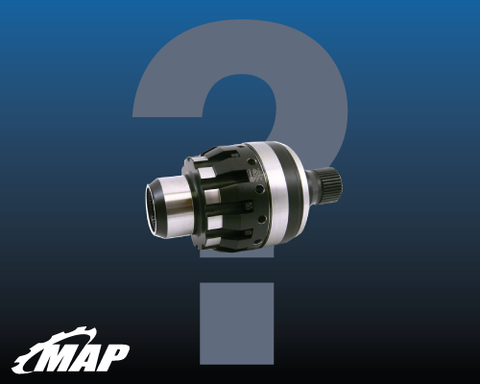What does a limited slip differential do?
A limited slip differential allows for more efficient handling and improved performance. It transfers engine power to the wheels that are getting the most grip on the ground using a mechanical system, electronics or a combination of the two.
You'll often see a limited slip differential fitted to performance cars that have plenty of power. These are used for situations where they need the extra traction and ability it offers, as every split-second counts on the track. From the WRX, EVOs, and even law enforcement vehicles, it has quickly cemented itself as a JDM performance icon. Buckle up–we’re taking a deep dive into the limited slip differential. Starting with exactly how it works.
How does a limited slip differential work?

Limited slip differentials are "torque sensing." Meaning they can shift torque to a car's drive wheels with the most amount of traction and limit the wheel with the least amount of traction.
There’s a collection of gears inside the differential that engage and work in unison to allow the inside wheel to rotate at different speeds than the outside wheel. These inner gears also dictate the car's axle ratio and control how much power a car can release on the road.
Rear-wheel drive limited slip differential benefits
After installing an LSD on your RWD car, you may feel that the car will have more oversteer than beforehand. Most vehicles straight off the factory line have quite a bit of understeer, so an LSD typically provides better steering for performance driving.
Four-wheel drive limited slip differential benefits
On FWD cars, the kind of LSD affects how your handling functions. When you install a 2 way differential (we'll go over types of limited slip differentials next), your car will handle drifting competitions like a beast. If a 1 way differential is installed, the LSD feature only happens when you're accelerating or "on-throttle". This generally provides a better line for track use.
There are different types of LSDs available. 1 way, 1.5 way, and 2 way LSDs.
1 way LSD
A 1 Way LSD is suited for front wheel drive cars and the front axle of AWD cars. With a 1 way differential, limited slip only happens upon accelerating, typically providing an advantage for straight-line track use.
1.5 way LSD
A 1.5 way differential is similar to a 1 way in that the LSD feature is applied upon acceleration, but it’s also half-applied when you’re off-throttle. It encourages low resistance through corners when maintaining speed when you don’t need a strong locking differential.
2 way LSD
With a 2 way LSD, the feature is ongoing during both acceleration and deceleration (on-throttle and off-throttle), enabling your car to preserve the same slip rate when cornering. And because it locks up harder, a 2 way LSD might be the best option if drifting is your thing.
The majority of vehicles on the road today use open differentials. Open differentials have inner gears as well, but they can’t make up for a loss in traction. There are a few other differences as well.
How to tell if you have a limited slip differential
A quick way to tell if you have a LSD or open differential is to jack your car (or use a car lift) and spin either of the rear tires. If the other wheel spins in the same direction, you have a limited slip diff. If it spins in the opposite direction, it's an open differential. Also, some manufacturers may input if the model was shipped from the factory with the type of differential. Check your VIN, as it may have that information.

Limited slip differential vs open differential
We’ll get technical for a second.
Limited slip and open differentials share one thing in common: The gears work in a similar fashion. They control torque between a car's two axles, applying drive to both sides and up to the maximum wheel grip. The amount of torque one wheel has over the other is known as "bias ratio," which is a measure of the torque distributed over the axle.
How does an open differential work?
Most open differentials carry a bias ratio of 1:1, meaning they're able to give just as much torque as there is traction at one wheel. When a wheel loses traction, the available drive is gone with the wind too. All your power goes to the slipping wheel, so you can spin out in performance settings and have poor acceleration. You likely have experienced this on a road somewhere. When a rear tire spins on ice or dirt, and as you try to accelerate more, that spinning tire just spins more and you stay where you are.
…vs a limited slip differential
Torque sensing differentials (like LSDs) offer increased and upgraded bias ratios over their open counterparts. If an LSD has a 2.5:1 bias ratio, then it will be able to distribute power to the wheel with the most grip at 2.5 times the grip limit of the wheel with the least amount of traction. Quite the performance enhancement.
Open differential advantages
Open differentials have been around for a long time for a good reason. They're still one of the best ways to prevent vehicle instability, wheel hop, and excess tire wear, as drive wheels are able to turn independently of each other. An open diff may be adequate for a road competition with good conditions.
An open differential is the most comfortable option for everyday driving. They’re reliable and an easy and affordable fix.
Open differential disadvantages
As we went over, the key disadvantage of the open differential is its inability to produce maximum pull from the engine. When open differentials are used on uneven or slippery surfaces, they don't work well because the engine torque is transmitted to whichever wheel has less traction. If a tire is off the ground or on ice, the wheels spin freely but there's no traction and thus the vehicle itself won't go anywhere.
Limited slip differential advantages
The main advantage of installing a limited slip diff is improved handling, as it gives the car and driver more control over its power delivery. You'll often find a limited-slip diff fitted to a modern performance car on the track and four-wheel-drive vehicles that go off-road and require extra traction that a limited slip differential can bring.
Limited slip differential disadvantages
Limited slip differentials can be a great option for cars that have limited traction, but they do come with some disadvantages. For starters their ability to provide 100% power distribution may not work well in all conditions. Furthermore, these types of differentials cost more than open differential models and there's extra maintenance needs and requirements too.
Applications
Limited slip differential for the 350Z and 370Z
The Super Lock LSD for the 350Z/370Z accomplishes complete lock in a continuous, smooth function. Enjoy the benefits of quick lap times, customization of full lock with stiffer pressure ring springs, and enhanced durability with high-quality materials.

Miata limited slip differential
If you're looking for the utmost traction for your Miata, look no further than the Cusco 1.5 way LSD. The Type RS quietly transfers maximum power without slip and for straight-line competitions or drifting.

EVO X front differential
Wavetrac's EVO X front differential is the answer to many performance issues with traction and cornering.The device generates a load inside the differential to offset any lost load. As a result, you'll have consistent power delivery through corners, ultimately making your car faster overall.

WRX limited slip differential
With high tension steel housing and gears, large oil windows for increased flow, the Cusco WRX rear LSD is down for some serious competition. It’s a 1.5 way out of the box that can easily be converted to a 2 way. Coil springs are used instead of cone plates, which promotes quicker, smoother engagement and higher durability. Grab one today!

LSD friction modifier
Limited slip differentials have plates that deliver the right amount of lock-up to the differential unit. Slippery lubricants and additives are needed to prevent chatter, but an excess of slipperiness causes unwanted wheel spin, reducing wheel traction. For great traction, you’ll need an LSD friction modifier like the Redline Synthetic Gear Oil: Limited Slip Friction Modifier. This friction modifier is designed to reduce the break in temperatures for differentials. It will work with either petroleum or synthetic oils, reducing temps by up to 50 degrees F!
How much friction modifier should you use?
It depends on your situation. The recommended dose of friction modifier for already broken-in differentials is 4%, which usually equates to one 4 oz. bottle. You can double that to 8% for new differentials that need to be broken in.

When it comes down to it, your choice of a differential can make or break your results on track day. With so many options, we know it can get overwhelming. We are standing by to help you find the right limited slip differential for you. Get in touch with MAP’s experienced experts today.





Comments (0)
There are no comments for this article. Be the first one to leave a message!